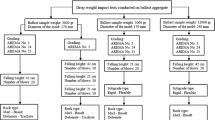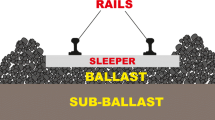Abstract
Assessment of the strength of parent rock is characterized as one of the most crucial step for selection of appropriate ballast material. In this regard, conducting the point load test (PLT) is a well-established procedure to determine the strength of rock core as well as fresh crushed aggregate. Meanwhile, the PLT is carried out under unconfined condition to axially apply conical concentrated load on the specimen, while the ballast layer comprises of assembly of aggregate in contact with each other. Therefore, providing lateral confinement in the PLT could be a more appropriate testing procedure to determine the strength of an individual particle. In the present study, a modified PLT was conducted on irregular-shaped ballast particles in which the bilateral point loading condition was provided on individual aggregates of different size ranges derived from various parent rock types. As expected, the results demonstrated that the confinement of single aggregate subjected to the conical loading led to the increment in the estimated strength. The failure patterns of individual ballast particles were substantially altered so that each particle was broken into higher number of fragments. The correlation between the results of PLT and the impact loading test further confirmed that the strength of the individual particles estimated based on the modified PLT could better correlate with the measured degradation levels of aggregate assembly subjected to impact loading.









Similar content being viewed by others
References
Indraratna, B.; Salim, W.; Rujikiatkamjorn, C.: Advanced rail Geotechnology—Ballasted Track. CRC Press, Roca Rotan (2011)
Afshar, T.; Disfani, M.M.; Arulrajah, A.; Narsilio, G.A.; Emam, S.: Impact of particle shape on breakage of recycled construction and demolition aggregates. Powder Technol. 38, 1–12 (2017)
Kahraman, S.: Evaluation of simple methods for assessing the uniaxial compressive strength of rock. Int. J. Rock Mech. Min. Sci. 38(7), 981–994 (2001)
Kong, F.; Shang, J.: A validation study for the estimation of uniaxial compressive strength based on index tests. Rock Mech. Rock Eng. 51(7), 2289–2297 (2018)
Wang, M.; Wan, W.: A new empirical formula for evaluating uniaxial compressive strength using the Schmidt hammer test. Int. J. Rock Mech. Min. Sci. 123, 104094 (2019)
Aladejare, A.E.: Evaluation of empirical estimation of uniaxial compressive strength of rock using measurements from index and physical tests. J. Mech. Geotech. Eng. 12(2), 256–268 (2020)
Aman, S.; Tomas, J.; Kalman, H.: Breakage probability of irregularly shaped particles. Chem. Eng. Sci. 65(5), 1503–1512 (2010)
Liu, Q.S.; Zhao, Y.F.; Zhang, X.P.: Case study: using the point load test to estimate rock strength of tunnels constructed by a tunnel boring machine. Bull. Eng. Geol. Env. 78(3), 1727–1734 (2019)
Kahraman, S.; Gunaydin, O.: Empirical methods to predict the abrasion resistance of rock aggregates. Bull. Eng. Geol. Env. 66(4), 449–455 (2007)
Kamani, M.; Ajalloeian, R.: Evaluation of the mechanical degradation of carbonate aggregate by rock strength test. J. Rock Mech. Geotech. Eng. 11, 121–134 (2018)
Lim, W.L.; McDowell, G.R.; Collop, A.C.: The application of Weibull statistics to the strength of railway ballast. Granular Matter 6(4), 229–237 (2004)
Koohmishi, M.; Palassi, M.: Evaluation of the strength of railway ballast using point load test for various size fractions and particle shapes. Rock Mech. Rock Eng. 49(7), 2655–2664 (2016)
Koohmishi, M.; Palassi, M.: Effect of particle size distribution and subgrade condition on degradation of railway ballast under impact loads. Granular Matter 19(3), 63–74 (2017)
Lackenby, J.; Indraratna, B.; McDowell, G.; Christie, D.: Effect of confining pressure on ballast degradation and deformation under cyclic triaxial loading. Géotechnique 57(6), 527–536 (2007)
Sun, Q.D.; Indraratna, B.; Nimbalkar, S.: Deformation and degradation mechanisms of railway ballast under high frequency cyclic loading. J. Geotech. Geoenviron. Eng. 142(1), 04015056 (2016)
Tkalich, D.; Fourmeau, M.; Kane, A.; Li, C.C.; Cailletaud, G.: Experimental and numerical study of Kuru granite under confined compression and indentation. Int. J. Rock Mech. Min. Sci. 87, 55–68 (2016)
Indraratna, B.; Ngo, T.; Rujikiatkamjorn, C.: Performance of ballast influenced by deformation and degradation: laboratory testing and numerical modeling. Int. J. Geomech. 20(1), 04019138 (2020)
Ling, X.; Xiao, H.; Liu, G.; Zhang, M.: Discrete element modeling of polyurethane-stabilized ballast under monotonic and cyclic triaxial loading. Constr. Build. Mater. 255, 119370 (2020)
ASTM C 535–03: Standard test method for resistance to degradation of large-size coarse aggregate by abrasion and impact in the Los Angeles machine. ASTM International, West Conshohocken, PA (2003)
ASTM D 5731–02: Standard test method for determination of the point load strength index of rock. American Society for Testing and Materials, ASTM D 5731–02 (2002)
Weibull, W.: A statistical distribution function of wide applicability. J. Appl. Mech. 18, 293–297 (1951)
Davidge, R.W.: Mechanical Behavior of Ceramics. Cambridge University Press, Cambridge (1979)
Qian, G.; Lei, W.S.; Yu, Z.; Berto, F.: Statistical size scaling of breakage strength of irregularly-shaped particles. Theoret. Appl. Fract. Mech. 102, 51–58 (2019)
Fang, K.; Zhao, T.; Zhang, Y.; Qiu, Y.; Zhou, J.: Rock cone penetration test under lateral confining pressure. Int. J. Rock Mech. Min. Sci. 119, 149–155 (2019)
Hokka, M.; Black, J.; Tkalich, D.; Fourmeau, M.; Kane, A.; Hoang, N.H.; Li, C.C.; Chen, W.W.; Kuokkala, V.T.: Effects of strain rate and confining pressure on the compressive behavior of Kuru granite. Int. J. Impact Eng 91, 183–193 (2016)
Du, H.B.; Dai, F.; Xu, Y.; Liu, Y.; Xu, H.N.: Numerical investigation on the dynamic strength and failure behavior of rocks under hydrostatic confinement in SHPB testing. Int. J. Rock Mech. Min. Sci. 108, 43–57 (2018)
Bahrani, N.; Kaiser, P.K.: Estimation of confined peak strength of crack-damaged rocks. Rock Mech. Rock Eng. 50(2), 309–326 (2017)
Koohmishi, M.: Evaluation of the effect of water saturation on the strength of individual railway ballast aggregate. Transp. Geotech. 18, 163–172 (2019)
Author information
Authors and Affiliations
Corresponding author
Ethics declarations
Conflict of interest
The author declares that there is no conflict of interest regarding the publication of this article.
Rights and permissions
About this article
Cite this article
Koohmishi, M. Assessing the Strength of Individual Railway Ballast Aggregate by Setting up Bilateral Point Loading Condition. Arab J Sci Eng 48, 4393–4402 (2023). https://doi.org/10.1007/s13369-022-06989-x
Received:
Accepted:
Published:
Issue Date:
DOI: https://doi.org/10.1007/s13369-022-06989-x




